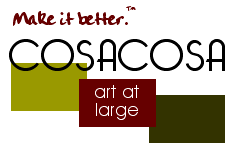



The coming of age of community-based arts has sparked growing curiosity about its history...
Jan Cohen-Cruz, a scholar of activist and community-based performance art, has pointed to what she describes as “historical markers” in the field of activist community art. The Harlem Renaissance (1919–1929) was an “early context for various models of African American activist art,” she writes. In the 1930s, there was a grassroots amateur movement of “workers creating theater for workers,” inspired by the Russian Revolution. “The lid finally blew off in the tumultuous 1960s, when broad questioning of the status quo once again found expression in the arts,” she writes. In that era, “identity politics” -- traditionally underrepresented and misrepresented groups coming together to express themselves -- became “a central trope in activist art.” El Teatro Campesino was created in the 1960s as a political organizing tool for farm workers.
Co-authors Don Adams and Arlene Goldbard, writing in New Creative Community: The Art of Cultural Development, noted that President Roosevelt’s New Deal included arts initiatives such as the “commissioning of murals, orphanages, libraries, museums, and other public buildings” and support for “visual art, music, theater, writing, and history.” New Deal cultural programs gave “jobs to artists who could not hope to make a living in the private economy,” including writers like Ralph Ellison and Richard Wright, painters like Jackson Pollack, and theater artists like Burt Lancaster, then a circus performer. “It suggested the possibility of a permanent role for artists in community service.”
In the 1970s and ’80s, cultural democracy -- a concept influenced by international exchanges with European groups -- provided a guiding vision for grassroots artists and cultural workers in the U.S. “Cultural democracy is predicated on the idea that diverse cultures should be treated as essentially equal in multicultural societies,” Adams and Goldbard write. They said this concept has been “promising,” but most practical applications have been “half-hearted.”
During this same period, the Comprehensive Employment and Training Act (CETA), a massive federal jobs program, was crafted as a government response to high unemployment. The program helped launch the careers of many artists working in communities. CETA put artists to work in schools, housing projects, community centers, and social service agencies. “There is scarcely a community artist who was around in the mid-’70s who did not either hold a CETA job or work directly with someone who did,” Adams and Goldbard write. CETA was eliminated by the Reagan administration in 1982.
If the U.S. economy stays in a period of protracted stagnation -- as it did during the Great Depression of the 1930s or the prolonged recession of the 1970s -- opportunities will abound to reassert the connection of the arts to community service, shedding new light on the constructive role of community-based arts organizations.
Marjorie Schwarzer, chair of the Department of Museum Studies at John F. Kennedy University in California, said the public “seeks solace in the arts during troubled times.” She noted, for example, that museum attendance rose during the Great Depression, the recession of the late 1970s, and after September 11, 2001. “Also, interestingly, private donations to museums increased,” she said.
Vanessa Whang, director of programs for the California Council for the Humanities, said people turn to cultural arts centers in hard times. “Community-based cultural centers are places where people can still interact face-to-face in a specific setting,” she said. “I think cities that don’t recognize this will be ignoring this at their own peril, particularly in a difficult economy.” According to Schwarzer, government employment programs like the Works Progress Administration during the 1930s and CETA during the 1970s “had a direct and lasting influence on public access to the arts, and these kinds of programs hold as much promise today as they did in their day.”
Ron Chew is principal of Chew Communications. As director of the Wing Luke Asian Museum from 1991-2007, he melded cultural identity, civic participation, and museum programs into a new tool in the fight for social justice. This essay is an excerpt from A New Center of Gravity, a publication of Animating Democracy, a program of Americans for the Arts.